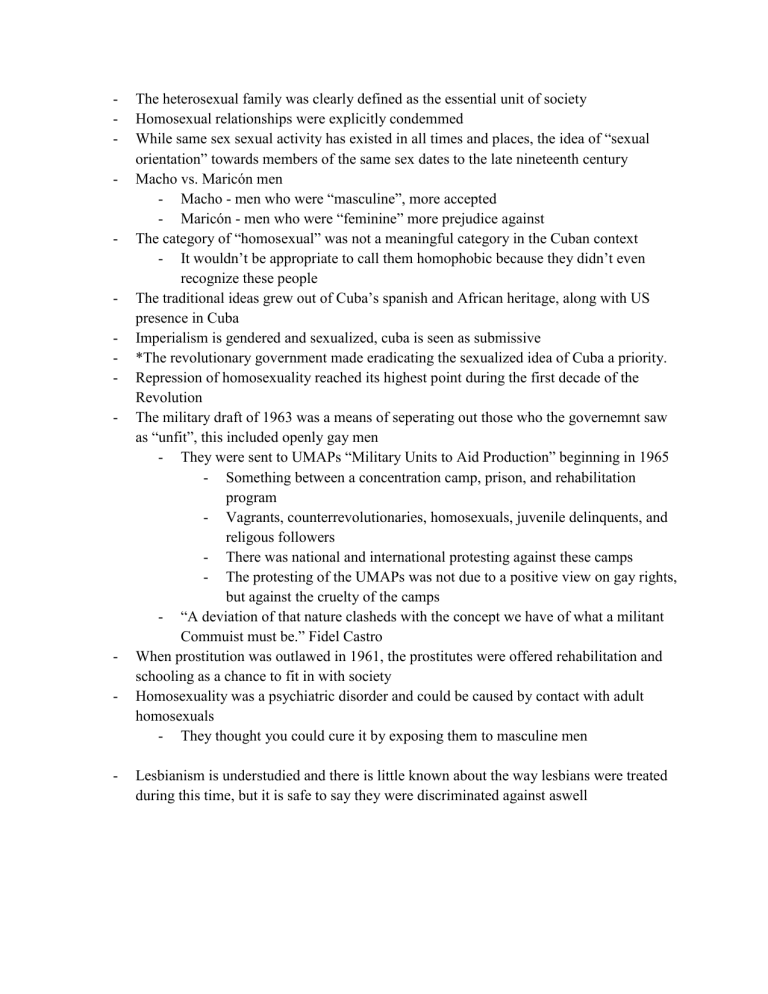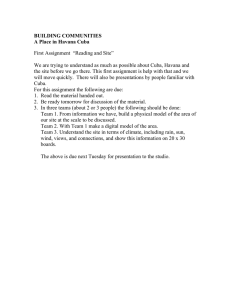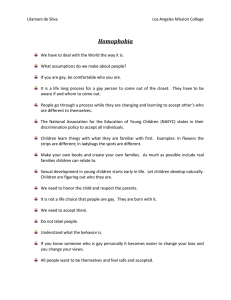
- - - - - The heterosexual family was clearly defined as the essential unit of society Homosexual relationships were explicitly condemmed While same sex sexual activity has existed in all times and places, the idea of “sexual orientation” towards members of the same sex dates to the late nineteenth century Macho vs. Maricón men - Macho - men who were “masculine”, more accepted - Maricón - men who were “feminine” more prejudice against The category of “homosexual” was not a meaningful category in the Cuban context - It wouldn’t be appropriate to call them homophobic because they didn’t even recognize these people The traditional ideas grew out of Cuba’s spanish and African heritage, along with US presence in Cuba Imperialism is gendered and sexualized, cuba is seen as submissive *The revolutionary government made eradicating the sexualized idea of Cuba a priority. Repression of homosexuality reached its highest point during the first decade of the Revolution The military draft of 1963 was a means of seperating out those who the governemnt saw as “unfit”, this included openly gay men - They were sent to UMAPs “Military Units to Aid Production” beginning in 1965 - Something between a concentration camp, prison, and rehabilitation program - Vagrants, counterrevolutionaries, homosexuals, juvenile delinquents, and religous followers - There was national and international protesting against these camps - The protesting of the UMAPs was not due to a positive view on gay rights, but against the cruelty of the camps - “A deviation of that nature clasheds with the concept we have of what a militant Commuist must be.” Fidel Castro When prostitution was outlawed in 1961, the prostitutes were offered rehabilitation and schooling as a chance to fit in with society Homosexuality was a psychiatric disorder and could be caused by contact with adult homosexuals - They thought you could cure it by exposing them to masculine men Lesbianism is understudied and there is little known about the way lesbians were treated during this time, but it is safe to say they were discriminated against aswell ● The dichotomy currently common in the US and Europe between heterosexual and homosexual os a cultural construction ○ The idea that indicvuals possess a “sexual orientation” to same or different sex is culturally and historically specific ○ Prior to the 19th century same-sex activcyt was a thing, but it was not seen as an identiy or a sexual orientation ○ Identifying it as an identity or orientation played a part in its view as abnormal ● Macho vs, Marcioon ○ Macho- stereotypically male ■ A male could be macho and have sexual relations with a man because of his masculinity ○ Marcion- a more effeminate man that did not adhere to normal masculinity ■ Levels of stigma against marcion men how had sexual relations with other men were comparable to the stigma against homeosxuals in the US ● This prejudice could not be labelled as homophobia since the category of homosexual was not even recognized. ● Traditional views towards homophobia grew out of Cuba;s Spanish, African. And most likely indigenous heritage ○ Also influenced by the increasing presence of US ideals ■ The US was very homophobic ● “Imperialism is inherently gendered and sexualized” ● Cuba was part and parcel of European imperial endeavors ○ Cuba, or the Orient, was passive and feminized, therefore waiting for European penetration ○ Manly notions of conquest defined the relationship between Cuba and the US ● Cuba was a tourism sight for pleasure and sin ○ The revolution government made eradicating this sexualized view of Cuba important ○ Sexuall reform became important to symbolizing the revolutions rejection of US domination ● Sexual reform did not incorporate ideas about gay rights ○ Even though in 60s and 70s US there was a gay rights revolution ■ Were beginning to recognize the gay identity ● Repression of homsexuality was at its highest during the beginning of the Revolution ○ Aided by the addition of Soviet ideology ○ Military draft allowed for authorities to divide subversives and those unfit ■ They sent them to a concentration camp, prison, and rehab program ○ Openly homsexual men fit into this categotu ■ A homesexal could never embody the conditions and requirements of conduct that would consider him a true Revolutionary ● Rehab not new to the Revolution ○ Make the ideal woman through the Ana Betancourt Schools for Peasant Women ■ Cementing views on women’s place ○ Prostitution outlawed in 1961 and they were over sent to rehabilitation and schooling ● Fun fact: Catholics and Gays were sent to UMAPS ○ Nationally and internationally there were protests of the UMAPS ■ These protests not for a positive view of gay rights, byt the cruelty of the camps ● Being gay was a psychiatric disorder, caused but contact with adult homosexuals and cured through exposure to masculine straight men ● Not until the 1989s that US style ideals about gay liberation and identity begain to take root ○ Western and Soviet thought retreated from the criminalization and stigatization of homsexuality ○ Gay acts decrominalised by 1979 ■ Flaunting it was illegal ● Strawberry and Chocolate - Tomas Guiterraz Alea’s 1994 film ○ Symbolized the political and social closing of the Special Period ○ Tells the tale of a Revolutionary, Diego (orthodox thinking), and David (unorthodox thinking) a Young Communist League member ■ David and Diego become friends and David helps Diego open his thinking Final presentation


